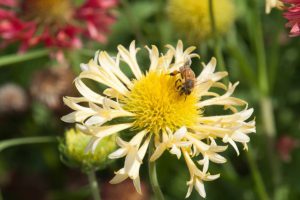Insects have a lot to do with ancestral flower power, study finds

Researchers shed more light on how insects pollinated the very first flower. (KarinD/Adobe)
The Botanic Gardens of Sydney has published a paper with researchers from Macquarie University and Western Sydney University, shedding more light on one of the earliest origin stories about the birds and the bees.
A large dataset examining what pollinators are relied on by 1,160 species of different flowering plant families has been examined to determine the long relationship insects have had with some of the earliest flowers.
By examining a state-of-the-art ‘evolutionary tree’, researchers believe that insects have pollinated angiosperms, or flowering plants, over most of the plant’s 140-million-year evolution.
The findings of the botanical science study were published in the journal New Phytologist on Tuesday.
Macquarie University PhD student Ruby E. Stephens was the lead author of the paper. She explained the evolutionary tree showed when certain plant families evolved, which helped to advance the understanding of plant history.
“This is a significant discovery, revealing a key aspect of the origin of almost all plants on Earth today,” Stephens said.
“By running different models, we can map backwards from what pollinates a plant in the present, to what might have pollinated the ancestor of that plant in the past.”
A total of 90% of today’s flowering plants are pollinated by insects and the colour, scent, and even sexual mimicry of these many flowers have evolved to attract insects.
However, a number of other flowers do not depend on insects and instead rely on vertebrate animals, wind or even water to transport pollen.
According to researchers, until this study it was not clear which form of flower pollination came first.
The authors further believe that the first flower was also likely to be insect-pollinated.
“Plants are the lifeblood of our planet, and our study highlights the importance of insects to plant reproduction throughout Earth’s history,” Stephens said.
Dr Hervé Sauquet from the Botanic Gardens’ plant discovery and evolution team noted that in addition to insect pollinators, the research uncovered how other forms of pollination changed over time.
Wind pollination, for example, was more likely to evolve in open habitats towards the poles. Meanwhile, locations such as closed rainforests near the equator were where animal pollination was more likely to take place.
“Pollination from vertebrate animals like birds, bats, small mammals, even lizards, has evolved and reverted numerous times throughout history,” Sauquet said.
“Wind pollination has also evolved many times, but it is harder to reverse — once plants go pollination by wind, they rarely go back.”
Washington University biology expert Professor Susanne Renner said the findings confirmed insects pollinated angiosperms for most of this plant lineage’s history.
“This underscores the need for the conservation of insects — their role as pollinators is essential for the continued existence of plants,” she said.
We are here to share current happenings in the bee industry. Bee Culture gathers and shares articles published by outside sources. For more information about this specific article, please visit the original publish source: Insects have a lot to do with ancestral flower power, study finds (themandarin.com.au)








